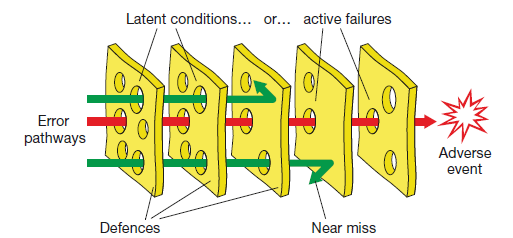Makindo Medical Notes"One small step for man, one large step for Makindo" |
|
|---|---|
| Download all this content in the Apps now Android App and Apple iPhone/Pad App | |
| MEDICAL DISCLAIMER: The contents are under continuing development and improvements and despite all efforts may contain errors of omission or fact. This is not to be used for the assessment, diagnosis, or management of patients. It should not be regarded as medical advice by healthcare workers or laypeople. It is for educational purposes only. Please adhere to your local protocols. Use the BNF for drug information. If you are unwell please seek urgent healthcare advice. If you do not accept this then please do not use the website. Makindo Ltd. |
Swiss Cheese Model of Patient Harm
-
| About | Anaesthetics and Critical Care | Anatomy | Biochemistry | Cardiology | Clinical Cases | CompSci | Crib | Dermatology | Differentials | Drugs | ENT | Electrocardiogram | Embryology | Emergency Medicine | Endocrinology | Ethics | Foundation Doctors | Gastroenterology | General Information | General Practice | Genetics | Geriatric Medicine | Guidelines | Haematology | Hepatology | Immunology | Infectious Diseases | Infographic | Investigations | Lists | Microbiology | Miscellaneous | Nephrology | Neuroanatomy | Neurology | Nutrition | OSCE | Obstetrics Gynaecology | Oncology | Ophthalmology | Oral Medicine and Dentistry | Paediatrics | Palliative | Pathology | Pharmacology | Physiology | Procedures | Psychiatry | Radiology | Respiratory | Resuscitation | Rheumatology | Statistics and Research | Stroke | Surgery | Toxicology | Trauma and Orthopaedics | Twitter | Urology
Related Subjects:
|Swiss Cheese Model of Patient Harm
|Safety Surgical checklist WHO
The Swiss Cheese Model, developed by James Reason, is one of the most influential frameworks for understanding how accidents and adverse events occur.
Originally applied in aviation and nuclear safety, it is now central to patient safety in healthcare, where complex systems and human factors intersect daily.
Reason highlighted that failures arise from the interaction of two key elements:
Each “slice of cheese” represents a defensive layer — policies, checklists, training, technology, barriers.
But all defenses have holes (weaknesses), created by human error or system flaws.
When holes across layers temporarily align, hazards pass through → an adverse event.
👉 Example: A prescribing error (active failure) + lack of electronic prescribing (latent condition) + inadequate pharmacy staffing → medication harm.
The model shifts focus from “Who is to blame?” (person-centered) to “What in the system allowed this to happen?”.
This systemic perspective has transformed healthcare safety culture.
The Swiss Cheese Model teaches that accidents occur when system flaws + human error align.
By layering defenses and fostering a culture of reporting, learning, and resilience, healthcare can prevent harm and deliver safer patient care.
Doctors should view themselves not just as clinicians, but as guardians of safety systems.
🧀 Introduction
⚡ Concept and Components
🧀 The Swiss Cheese Analogy

📊 A Systems Approach to Errors
🏥 Application in Healthcare
🌟 Key Lessons
✅ Conclusion
📚 References